Massive Azure Platform Update: All TechEd NA 2014 Announcements
As part of this news digest, the Microsoft Azure cloud platform brings together major announcements for developers, IT professionals, and for all professionals interested in cloud technologies and the Azure platform. Previous editions of the digest can always be found at the following link .

These days, the largest Microsoft TechEd NA 2014 conference is being held, within which many announcements were made, including on the Microsoft Azure platform technologies.
')
This digest contains all announcements and other news from the past month, voiced at the conference:
Consider these new items in more detail.
One of the most notorious announcements of TechEd NA 2014 was Azure RemoteApp , a service released in public pre-testing that allows you to host existing Windows client applications in the Azure cloud and access them from any computers, tablets, laptops or phones via an RDP client (supplied by Microsoft for Windows, Mac OS X, iOS and Android).
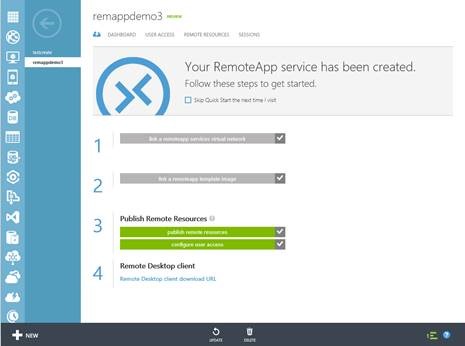
Azure RemoteApp offers the ability to effectively scale the computing power required for remote users to work, dynamically allocating or reducing power on demand or automatically.
The service provides a high level of security for remote work with applications. At the same time, the applications themselves are not stored and are not recorded on user devices, but are offered for centralized remote access.
Azure RemoteApp supports hybrid scenarios and can be integrated with the existing infrastructure for hosting applications on their side.
For a period of public testing, the Azure RemoteApp service is available for free to 20 users. Pay attention to the conditions of use of the service during testing.
You can request access to the RemoteApp preview at the following link . Details about the service, answers to frequently asked questions can be found on the portal , documentation and examples are available here . Visit the official website to access customer applications. View the in-depth report on Azure RemoteApp Deep Dive .
Another high-profile announcement by TechEd NA 2014 was the launch of preliminary testing of the API Management service. This service offers developers their own API the opportunity to get a full-fledged environment for managing, monitoring and administering their API hosted anywhere, either in the cloud or on any hosting, including its own infrastructure.

API Management is essentially an intermediate proxy service that not only protects access to your own API based on rich sets of security functions, but also allows you to track API usage statistics, use rich analytics tools, set quotas, different API access subscriptions, scale under load and centrally cache the results of user requests.

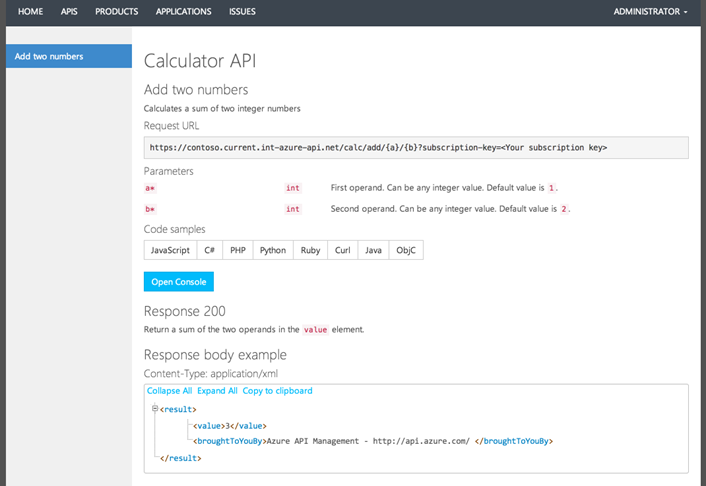
One of the most interesting features of API Management is the special portal provided to each developer who has published his API, which is based on the Orchard CMS with the possibility of deep customization for his own design. This portal is used to provide access to the API for external clients of the service with a description of all the features of the API, including code examples in various programming languages that are generated on the portal automatically. You can read an article on customization and use of this developer portal at the following link .
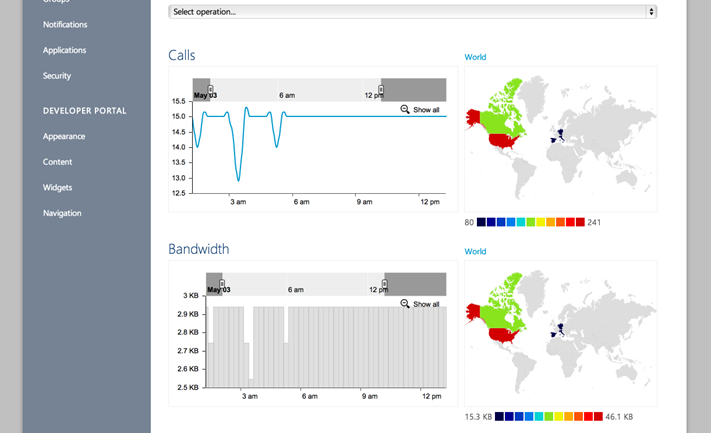

Another great feature is the interactive console, which will allow developers to test the API directly on the portal, setting request parameters and managing HTTP request headers.
Useful links:
You can use the new Azure API Management service today .
Another great announcement by TechEd NA 2014 was the launch of a distributed caching service based on Redis (REmote DIctionary Server) available on request in the cloud. Redis is a popular opensource technology designed for building distributed data storage systems of the key-value type in memory.
The Azure Redis Cache service will allow you to get ready-made redis-storage with the required size for data caching tasks on the first request. For developers, two levels of service are offered: simple (basic) and standard (standard). Simply, the service level is offered as a single node of the redis-storage. This level of service is ideal for non-critical tasks during development and testing. The standard layer supports node replication for added reliability.
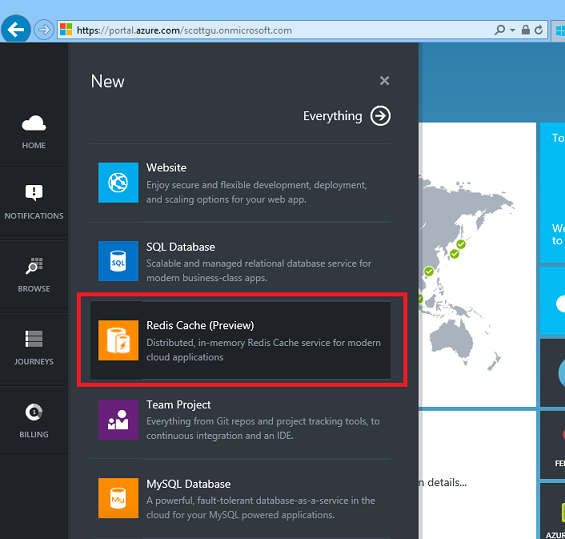

An instance of the Azure Redis Cache service can be created in the new Azure portal . After creating an instance of the service, the portal offers a set of functions for monitoring work and access to the service settings. Access to the redis-repository can be made from a variety of programming languages. Access keys are available on the portal.
Information on service prices can be obtained on the official website :
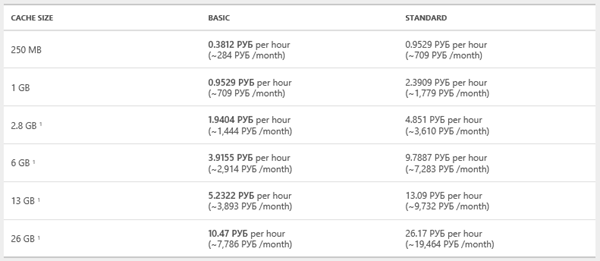
Useful links:
You can try the Azure Redis Cache service today .
The Azure virtual machine infrastructure platform has received some interesting updates.
New high-performance VM A8 and A9 with InfiniBand
Virtual A8 (8 cores, 56GB RAM) and A9 (16 cores, 112 GB RAM) sized virtual machines have become available for Microsoft Azure users that are intended for use in high-load solutions. Previously, these machines were available in Azure only as cloud services. These types of virtual machines are provided with a high-performance network based on InfiniBand.

To create these types of virtual machines, you must use the command line commands. Creation through the portal is not yet available.
Details can be found in this article .
Built-in support for antivirus features
The Microsoft Azure virtual machine infrastructure has the function of agents that can be automatically installed on the machine to perform various functions, such as centralized management. An example of an agent is an agent integrating a VM with a Puppet server.
In the platform update, new agents for virtual machines were added - security extensions, anti-virus modules that can be automatically added to the VM when it is created and deployed. Today, Microsoft Azure offers a choice of three agents: Microsoft Antimalware, Symantec Endpoint Protection, TrendMicro's Deep Security Agent.

Another agent was added to the list of agents - Custom Script, which allows you to execute an arbitrary PowerShell script on the machine immediately after creating the virtual machine, which allows you to automate various functions of deploying environments in the VM.
VM Image Capture Support
Earlier this year, at the Build conference, a function was introduced for capturing images of virtual machines containing both the VM image itself and all virtual disks attached to it. The feature presented was available for use only through command line scripts.
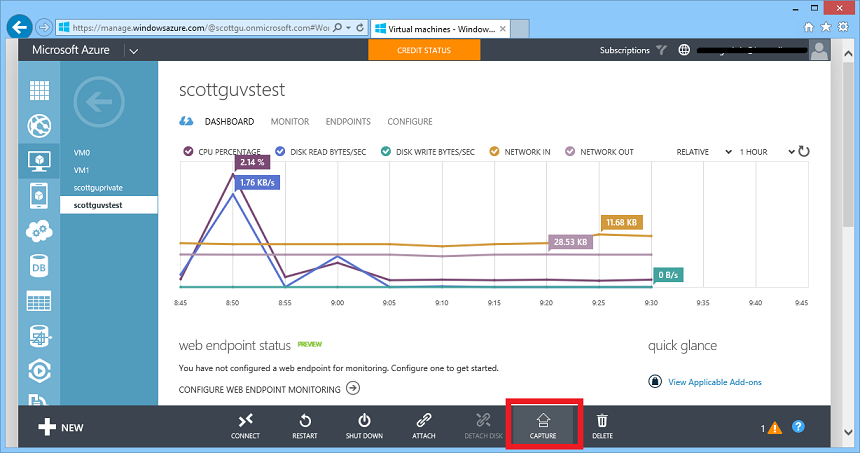
In the latest platform update, the function of removing complete VM images has been added to the portal for easier access to it. The new feature allows you to capture images of both stopped and running VMs and without the need to restart. The captured images are immediately available for redeployment.
Java 8 in the VM Image Gallery
After the conclusion of a strategic partnership with Orale, many Oracle server products were added to the image gallery of virtual machines, including a ready-to-use image with a deployed environment for running JDK applications.
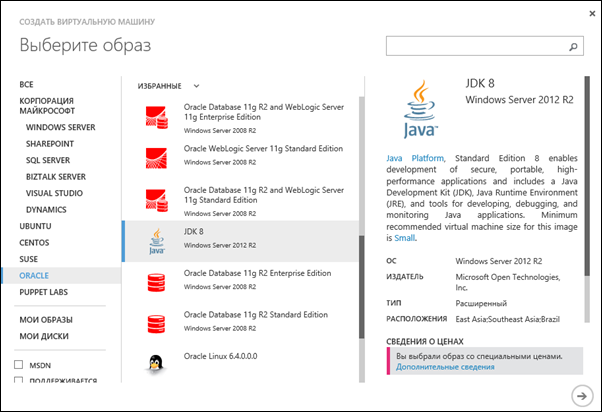
Some time ago an image with JDK8 officially supported by Oracle was added to the list of images.
Along with the new virtual machine infrastructure features, interesting new virtual networking and networking features have been added to Azure.
ExpressRoute service release
The Azure ExpressRoute service offers users the ability to connect their own infrastructure directly to Microsoft Azure data centers bypassing the Internet as an intermediate link. This feature allows you to guarantee the availability and quality of networking, expanding your infrastructure in a natural way.
Earlier, ExpressRoute was in preliminary testing, it is constantly evolving and expanding the network of partners that are involved in providing services. With the new update, the service was released into commercial operation and became available through an even larger number of partners: AT & T, Equinix, Verizon, BT, Level3, TelecityGroup, SingTel and Zadara.
Currently, the Azure ExpressRoute service is available only through specified partners, but this list is constantly growing. Terms of service you can find on the official page .
Multiple VPN support
A very demanded function of connecting multiple VPNs in a virtual network was put into commercial operation. This feature allows you to connect your virtual network inside Azure to multiple networks within your local infrastructure.
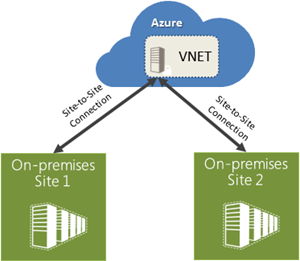
Details on the page description of virtual networks.
Communication type VNET-VNET
Another feature that has been added to the Azure network infrastructure is the ability to combine multiple virtual networks with each other.

Networks can be located in one region or in different regions of Azure. Details on the page description of virtual networks.
IP reservation
The new ability to reserve public IP addresses for your applications allows you to reserve and use up to 5 IP addresses for the purposes of your applications for free within one subscription. Additional number of IP addresses can be purchased for a fee. Reserved IPs can be assigned to selected VMs or cloud services.
Today, users can reserve IP via command line scripts:
In the future, the possibility of IP reservation will be added to the portal for ease of use.
With the announcement of this function, it is now possible to assign specific IP addresses to virtual machines and directly access them. This allows you to simplify a number of scenarios for placing infrastructure in the cloud, for example, FTP servers. You can learn more about the possibilities at the following link .
Internal load balancing
The new internal load balancing feature allows Azure clients to balance traffic within the network to private IP addresses. Internal load balancing can be useful for multi-tier systems where some of the links, such as the database level, are hidden inside the infrastructure, but still need load balancing.
Internal load balancing is available for the standard VM level at no additional cost. This feature is currently in pre-testing and is only available for newly created virtual machines.
Traffic Manager External Endpoints Release
Traffic Manager service allows you to route traffic between Azure datacenters depending on different conditions and for different purposes - load balancing or fault tolerance.
In the update, a new Traffice Manager feature has been added to route traffic not only for Azure internal resources, but also for external user resources. Azure clients can now centrally route traffic between Azure endpoints, their own servers, or even other cloud providers.
The new feature is available in the preview and today can only be configured via command line scripts.
For the Microsoft Azure storage at TechEd conference, several important announcements were made.
Release of service of import / export of data carriers
The Azure Import / Export service offers the ability for cloud platform users to send and receive massive amounts of data (files) on media (HDD) to Azure infrastructure to speed up the download or upload of data from the cloud.
This service was previously available as a preview and at TechEd, Azure Import / Export was announced for commercial use. With this announcement, the service received a number of new features: the list of regions that support data import / export was expanded, the service became available in the USA, Europe and Asia, it became possible to use both DHL and FedEx for delivery by simply specifying the account number with the supplier .
Questions about the operation of the service can be sent to the public address waimportexport@microsoft.com .
New shared SMB storage service
The most important announcement regarding the storage of data in the Azure cloud was the announcement of the new service Azure SMB File Sharing . This service allows access to Azure Storage data as a network resource using the SMB protocol, which allows familiar access to data from virtual machines via network interaction.
Windows or Linux virtual machines can read and write files in the new service using the SMB protocol, and at the same time, the REST interface for building applications that may need access to the stored files is also offered to access the files.
The Azure SMB File Sharing service is built on the same infrastructure as Azure Storage Blobs, Tables and Queues, which means high reliability, availability and redundancy of data storage. The service itself is managed by the Azure infrastructure, which allows customers to receive a ready-made SMB file storage infrastructure without creating and configuring virtual machines.
Additional information about the service is available at the following link .
Thanks to the new integration features introduced, it became possible to connect cloud resources such as websites and mobile services with databases hosted on the company's own infrastructure within the company's local network. Now developers have an easy opportunity to build cloudy web and mobile applications, services and a mobile backend with data that will be permanently placed on their servers.
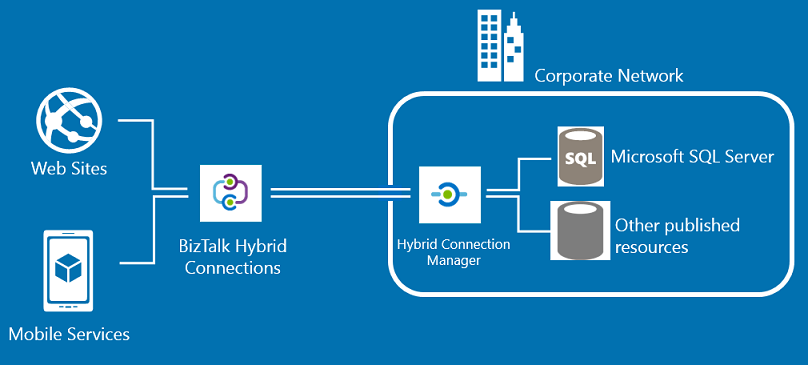
To provide a hybrid scenario of linking mobile services and websites to the local infrastructure, a new free level of BizTalk Services was introduced. Thanks to this innovation, the new hybrid scenario does not require additional payment.
An important positive feature of this scenario is that developers do not need to open or configure VPN channels for communication between an enterprise and a cloud backend. Instead, BizTalk Services offers the ability to provide hybrid scenarios without further configuring the network or reducing its security.
Hybrid connections support all frameworks and programming languages that are supported by websites (currently .NET, Java, PHP, Python, Node.js) and mobile services backend (.NET and Node.js).
You can learn more about the new features at the following links:
You can try new integration features of mobile services and websites today.
To administer and manage the new Microsoft Azure features, new features and a set of scripts were introduced.
Over 40 new Azure PowerShell cmdlets
A new version of the Azure PowerShell command-line administration tools has become available to Azure administrators and developers, with 49 new cmdlets added for solving various tasks, including:
Like all the other tools in Azure, these command sets are distributed open source. Details about the new features and a full list of new commands can be found on the GiHub .
Azure Active Directory removal feature
Small, but pleasant and long-awaited innovation. Azure users can now delete the previously created Azure Active Directory directories using the administration portal interface.

Now you can do it with a simple command after selecting a specific directory from the list.
New Cloud App Discovery feature in Azure Active Directory
At the end of April, a new module for the cloud implementation of the Azure Active Directory directory was introduced in the official blog of the Active Directory team. The new functionality is called the Cloud App Discovery and is designed to automatically detect the cloud services used within the enterprise.
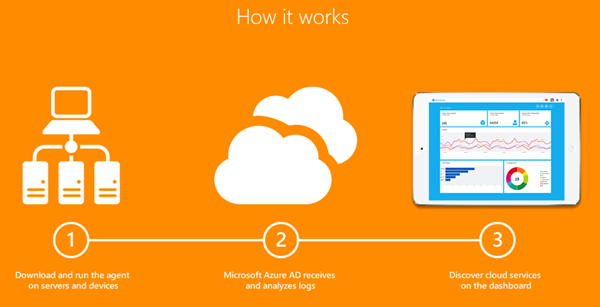
Administrators and certain employees can analyze the situation inside their company by quickly compiling a complete picture of which of the SaaS services are used internally by its employees. In the future, each of these services can be integrated with Azure Active Directory for centralized management of access rights and security.
You can try the new service right now: http://appdiscovery.azure.com/ .
Over the past month there have been several news about the Azure Media Services media platform.
Free e-book about building media solutions based on Azure services
The next free e-book from the Patterns & Practices group on the Azure platform saw the light. The book Building with On-Demand Video Service with Microsoft Azure Media Services contains a complete guide to building cloud-based media services for delivering content to users on terbing on any platforms and devices.
The book is presented by the following chapters:
Download an e-book or read it online at the following link on MSDN .
Support for playing HLS data on Android
The Azure Media Services team has announced the announcement of the HLS (Http Live Streaming, version 3) delivery of media content to Android devices and has published a short guide. You can find the description at the following link .
In the official Azure blog entry called Big Compute for Microsoft Azure , the acquisition of the GreenButton service by Microsoft was announced.
GreenButton is a popular cloud service that offered the ability to migrate applications that require huge computing resources to the cloud environment. Such applications and services at the time were the following popular tools: Blender, Brazil, Geneious, LuxRender, Yafaray, Deep Exploration, GreenButton inCus, RenderMan On Demand, Numerix.
The new acquisition will add to the rich cloud services family of the Microsoft Azure platform and will soon provide Azure cloud users with access to their capabilities upon request.
Below you will find links to resources that will help you in using the Microsoft cloud platform:
And if you are already developing on Windows Azure or want to find the developers of your service, visit the service appprofessionals.ru .
We will be happy to answer your questions at azurerus@microsoft.com . And we are waiting for you in the Windows Azure Community on Facebook . Here you will find experts (don't forget to ask them questions), photos, and lots and lots of news.

These days, the largest Microsoft TechEd NA 2014 conference is being held, within which many announcements were made, including on the Microsoft Azure platform technologies.
')
This digest contains all announcements and other news from the past month, voiced at the conference:
- New services!
- Remote App - launching client applications in the cloud with access on any RDP client;
- API Management - centralized management, control, access to your API located anywhere
- Redis -based cache - distributed cache for your services based on the popular opensource-tool;
- Virtual machines New high-performance VM A8 and A9 with InfiniBand. Built-in support for antivirus functions. Support for removing VM images. Java 8 in the VM Image Gallery;
- Network functions ExpressRoute service release. Multiple VPN support. Communication type VNET-VNET. IP reservation. Internal load balancing. Release of Traffic Manager External Endpoints;
- Storage . Release service import / export data carriers. New shared SMB storage service;
- Integration . New features for integrating websites and mobile services with data and applications within the enterprise;
- Administration . Over 40 new Azure PowerShell cmdlets. The function to delete the directory Azure Active Directory. New Cloud App Discovery feature in Azure Active Directory;
- Media Services . Free e-book about building media solutions based on Azure services. Support for playing HLS data on Android;
- Microsoft acquires cloud service GreenButton.
Consider these new items in more detail.
New RemoteApp service
One of the most notorious announcements of TechEd NA 2014 was Azure RemoteApp , a service released in public pre-testing that allows you to host existing Windows client applications in the Azure cloud and access them from any computers, tablets, laptops or phones via an RDP client (supplied by Microsoft for Windows, Mac OS X, iOS and Android).

Azure RemoteApp offers the ability to effectively scale the computing power required for remote users to work, dynamically allocating or reducing power on demand or automatically.
The service provides a high level of security for remote work with applications. At the same time, the applications themselves are not stored and are not recorded on user devices, but are offered for centralized remote access.
Azure RemoteApp supports hybrid scenarios and can be integrated with the existing infrastructure for hosting applications on their side.
For a period of public testing, the Azure RemoteApp service is available for free to 20 users. Pay attention to the conditions of use of the service during testing.
You can request access to the RemoteApp preview at the following link . Details about the service, answers to frequently asked questions can be found on the portal , documentation and examples are available here . Visit the official website to access customer applications. View the in-depth report on Azure RemoteApp Deep Dive .
New API Management Service
Another high-profile announcement by TechEd NA 2014 was the launch of preliminary testing of the API Management service. This service offers developers their own API the opportunity to get a full-fledged environment for managing, monitoring and administering their API hosted anywhere, either in the cloud or on any hosting, including its own infrastructure.

API Management is essentially an intermediate proxy service that not only protects access to your own API based on rich sets of security functions, but also allows you to track API usage statistics, use rich analytics tools, set quotas, different API access subscriptions, scale under load and centrally cache the results of user requests.


One of the most interesting features of API Management is the special portal provided to each developer who has published his API, which is based on the Orchard CMS with the possibility of deep customization for his own design. This portal is used to provide access to the API for external clients of the service with a description of all the features of the API, including code examples in various programming languages that are generated on the portal automatically. You can read an article on customization and use of this developer portal at the following link .


Another great feature is the interactive console, which will allow developers to test the API directly on the portal, setting request parameters and managing HTTP request headers.
Useful links:
- Easily create an API façade for the existing backend services
- Quickly add new capabilities to the APIs, such as response and cross domain access
- Package and publish APIs for developers and partners
- Reliably protect published APIs from misuse and abuse
- Azure API Management developer center
You can use the new Azure API Management service today .
New cache service based on Redis
Another great announcement by TechEd NA 2014 was the launch of a distributed caching service based on Redis (REmote DIctionary Server) available on request in the cloud. Redis is a popular opensource technology designed for building distributed data storage systems of the key-value type in memory.
The Azure Redis Cache service will allow you to get ready-made redis-storage with the required size for data caching tasks on the first request. For developers, two levels of service are offered: simple (basic) and standard (standard). Simply, the service level is offered as a single node of the redis-storage. This level of service is ideal for non-critical tasks during development and testing. The standard layer supports node replication for added reliability.


An instance of the Azure Redis Cache service can be created in the new Azure portal . After creating an instance of the service, the portal offers a set of functions for monitoring work and access to the service settings. Access to the redis-repository can be made from a variety of programming languages. Access keys are available on the portal.
Information on service prices can be obtained on the official website :

Useful links:
You can try the Azure Redis Cache service today .
New features of virtual machines
The Azure virtual machine infrastructure platform has received some interesting updates.
New high-performance VM A8 and A9 with InfiniBand
Virtual A8 (8 cores, 56GB RAM) and A9 (16 cores, 112 GB RAM) sized virtual machines have become available for Microsoft Azure users that are intended for use in high-load solutions. Previously, these machines were available in Azure only as cloud services. These types of virtual machines are provided with a high-performance network based on InfiniBand.

To create these types of virtual machines, you must use the command line commands. Creation through the portal is not yet available.
PS C: \> New-AzureQuickVM -windows –ServiceName mya8vm -name mya8vm -imagename $ image -instancesize A8 –AdminUserName $ admin –password $ pwd -location "West US"
Details can be found in this article .
Built-in support for antivirus features
The Microsoft Azure virtual machine infrastructure has the function of agents that can be automatically installed on the machine to perform various functions, such as centralized management. An example of an agent is an agent integrating a VM with a Puppet server.
In the platform update, new agents for virtual machines were added - security extensions, anti-virus modules that can be automatically added to the VM when it is created and deployed. Today, Microsoft Azure offers a choice of three agents: Microsoft Antimalware, Symantec Endpoint Protection, TrendMicro's Deep Security Agent.

Another agent was added to the list of agents - Custom Script, which allows you to execute an arbitrary PowerShell script on the machine immediately after creating the virtual machine, which allows you to automate various functions of deploying environments in the VM.
VM Image Capture Support
Earlier this year, at the Build conference, a function was introduced for capturing images of virtual machines containing both the VM image itself and all virtual disks attached to it. The feature presented was available for use only through command line scripts.

In the latest platform update, the function of removing complete VM images has been added to the portal for easier access to it. The new feature allows you to capture images of both stopped and running VMs and without the need to restart. The captured images are immediately available for redeployment.
Java 8 in the VM Image Gallery
After the conclusion of a strategic partnership with Orale, many Oracle server products were added to the image gallery of virtual machines, including a ready-to-use image with a deployed environment for running JDK applications.

Some time ago an image with JDK8 officially supported by Oracle was added to the list of images.
New network features
Along with the new virtual machine infrastructure features, interesting new virtual networking and networking features have been added to Azure.
ExpressRoute service release
The Azure ExpressRoute service offers users the ability to connect their own infrastructure directly to Microsoft Azure data centers bypassing the Internet as an intermediate link. This feature allows you to guarantee the availability and quality of networking, expanding your infrastructure in a natural way.
Earlier, ExpressRoute was in preliminary testing, it is constantly evolving and expanding the network of partners that are involved in providing services. With the new update, the service was released into commercial operation and became available through an even larger number of partners: AT & T, Equinix, Verizon, BT, Level3, TelecityGroup, SingTel and Zadara.
Currently, the Azure ExpressRoute service is available only through specified partners, but this list is constantly growing. Terms of service you can find on the official page .
Multiple VPN support
A very demanded function of connecting multiple VPNs in a virtual network was put into commercial operation. This feature allows you to connect your virtual network inside Azure to multiple networks within your local infrastructure.

Details on the page description of virtual networks.
Communication type VNET-VNET
Another feature that has been added to the Azure network infrastructure is the ability to combine multiple virtual networks with each other.

Networks can be located in one region or in different regions of Azure. Details on the page description of virtual networks.
IP reservation
The new ability to reserve public IP addresses for your applications allows you to reserve and use up to 5 IP addresses for the purposes of your applications for free within one subscription. Additional number of IP addresses can be purchased for a fee. Reserved IPs can be assigned to selected VMs or cloud services.
Today, users can reserve IP via command line scripts:
# IP reservation
New-AzureReservedIP -ReservedIPName EastUSVIP -Label "Reserved VIP in EastUS" -Location "East US"
# Using IP when placing
New-AzureVM -ServiceName "MyApp" -VMs $ web1 -Location "East US" -VNetName VNetUSEast -ReservedIPName EastUSVIP
In the future, the possibility of IP reservation will be added to the portal for ease of use.
With the announcement of this function, it is now possible to assign specific IP addresses to virtual machines and directly access them. This allows you to simplify a number of scenarios for placing infrastructure in the cloud, for example, FTP servers. You can learn more about the possibilities at the following link .
Internal load balancing
The new internal load balancing feature allows Azure clients to balance traffic within the network to private IP addresses. Internal load balancing can be useful for multi-tier systems where some of the links, such as the database level, are hidden inside the infrastructure, but still need load balancing.
Internal load balancing is available for the standard VM level at no additional cost. This feature is currently in pre-testing and is only available for newly created virtual machines.
Traffic Manager External Endpoints Release
Traffic Manager service allows you to route traffic between Azure datacenters depending on different conditions and for different purposes - load balancing or fault tolerance.
In the update, a new Traffice Manager feature has been added to route traffic not only for Azure internal resources, but also for external user resources. Azure clients can now centrally route traffic between Azure endpoints, their own servers, or even other cloud providers.
The new feature is available in the preview and today can only be configured via command line scripts.
New cloud storage features
For the Microsoft Azure storage at TechEd conference, several important announcements were made.
Release of service of import / export of data carriers
The Azure Import / Export service offers the ability for cloud platform users to send and receive massive amounts of data (files) on media (HDD) to Azure infrastructure to speed up the download or upload of data from the cloud.
This service was previously available as a preview and at TechEd, Azure Import / Export was announced for commercial use. With this announcement, the service received a number of new features: the list of regions that support data import / export was expanded, the service became available in the USA, Europe and Asia, it became possible to use both DHL and FedEx for delivery by simply specifying the account number with the supplier .
Questions about the operation of the service can be sent to the public address waimportexport@microsoft.com .
New shared SMB storage service
The most important announcement regarding the storage of data in the Azure cloud was the announcement of the new service Azure SMB File Sharing . This service allows access to Azure Storage data as a network resource using the SMB protocol, which allows familiar access to data from virtual machines via network interaction.
Windows or Linux virtual machines can read and write files in the new service using the SMB protocol, and at the same time, the REST interface for building applications that may need access to the stored files is also offered to access the files.
The Azure SMB File Sharing service is built on the same infrastructure as Azure Storage Blobs, Tables and Queues, which means high reliability, availability and redundancy of data storage. The service itself is managed by the Azure infrastructure, which allows customers to receive a ready-made SMB file storage infrastructure without creating and configuring virtual machines.
Additional information about the service is available at the following link .
New integration features
Thanks to the new integration features introduced, it became possible to connect cloud resources such as websites and mobile services with databases hosted on the company's own infrastructure within the company's local network. Now developers have an easy opportunity to build cloudy web and mobile applications, services and a mobile backend with data that will be permanently placed on their servers.

To provide a hybrid scenario of linking mobile services and websites to the local infrastructure, a new free level of BizTalk Services was introduced. Thanks to this innovation, the new hybrid scenario does not require additional payment.
An important positive feature of this scenario is that developers do not need to open or configure VPN channels for communication between an enterprise and a cloud backend. Instead, BizTalk Services offers the ability to provide hybrid scenarios without further configuring the network or reducing its security.
Hybrid connections support all frameworks and programming languages that are supported by websites (currently .NET, Java, PHP, Python, Node.js) and mobile services backend (.NET and Node.js).
You can learn more about the new features at the following links:
- Description: Hybrid Connections
- Instructions: Connect an Azure Website with an On-Premises Resource
- Tutorial: SQL Server Using Hybrid Connections
- Guide: Connect an Azure Mobile Services .NET Backend to an On-Premises Resource using Hybrid Connections
- Article - Connect to an Azure mobile service using Hybrid Connections
- Video - Connect to an SQL Server from Azure Mobile Services using Hybrid Connections
You can try new integration features of mobile services and websites today.
New administration features
To administer and manage the new Microsoft Azure features, new features and a set of scripts were introduced.
Over 40 new Azure PowerShell cmdlets
A new version of the Azure PowerShell command-line administration tools has become available to Azure administrators and developers, with 49 new cmdlets added for solving various tasks, including:
- Capacity and Network Management
- Public IP support
- Reserved IP support
- Support Internal load balancer
- Improving the management of virtual disks and VM images
- Enhance virtual network management (Set-AzureVnetGatewayKey)
- Cmdlets to manage Azure Automation service
- Cmdlets for managing the Traffic Manager service
- Anti-Malware Cloud Service VM Management Cmdlets
Like all the other tools in Azure, these command sets are distributed open source. Details about the new features and a full list of new commands can be found on the GiHub .
Azure Active Directory removal feature
Small, but pleasant and long-awaited innovation. Azure users can now delete the previously created Azure Active Directory directories using the administration portal interface.

Now you can do it with a simple command after selecting a specific directory from the list.
New Cloud App Discovery feature in Azure Active Directory
At the end of April, a new module for the cloud implementation of the Azure Active Directory directory was introduced in the official blog of the Active Directory team. The new functionality is called the Cloud App Discovery and is designed to automatically detect the cloud services used within the enterprise.

Administrators and certain employees can analyze the situation inside their company by quickly compiling a complete picture of which of the SaaS services are used internally by its employees. In the future, each of these services can be integrated with Azure Active Directory for centralized management of access rights and security.
You can try the new service right now: http://appdiscovery.azure.com/ .
Media Services News
Over the past month there have been several news about the Azure Media Services media platform.
Free e-book about building media solutions based on Azure services
The next free e-book from the Patterns & Practices group on the Azure platform saw the light. The book Building with On-Demand Video Service with Microsoft Azure Media Services contains a complete guide to building cloud-based media services for delivering content to users on terbing on any platforms and devices.
The book is presented by the following chapters:
- Introduction to Microsoft Azure Media Services
- The Azure Media Services Video-on-Demand Scenario
- Uploading Video into Microsoft Azure Media Services
- Microsoft Azure Media Services Encoding and Processing
- Delivering and Consuming Video from Microsoft Azure Media Services
Download an e-book or read it online at the following link on MSDN .
Support for playing HLS data on Android
The Azure Media Services team has announced the announcement of the HLS (Http Live Streaming, version 3) delivery of media content to Android devices and has published a short guide. You can find the description at the following link .
GreenButton Cloud Service
In the official Azure blog entry called Big Compute for Microsoft Azure , the acquisition of the GreenButton service by Microsoft was announced.
GreenButton is a popular cloud service that offered the ability to migrate applications that require huge computing resources to the cloud environment. Such applications and services at the time were the following popular tools: Blender, Brazil, Geneious, LuxRender, Yafaray, Deep Exploration, GreenButton inCus, RenderMan On Demand, Numerix.
The new acquisition will add to the rich cloud services family of the Microsoft Azure platform and will soon provide Azure cloud users with access to their capabilities upon request.
useful links
Below you will find links to resources that will help you in using the Microsoft cloud platform:
- Free 30-day trial of Windows Azure;
- Free access to Windows Azure resources for startups , partners , teachers, MSDN subscribers ;
- Windows Azure Development Center (azurehub.ru) - scripts, tutorials, examples, recommendations on the choice of services and development on Windows Azure;
- Latest Windows Azure News - Twitter.com/windowsazure_ru .
And if you are already developing on Windows Azure or want to find the developers of your service, visit the service appprofessionals.ru .
We will be happy to answer your questions at azurerus@microsoft.com . And we are waiting for you in the Windows Azure Community on Facebook . Here you will find experts (don't forget to ask them questions), photos, and lots and lots of news.
Source: https://habr.com/ru/post/223467/
All Articles